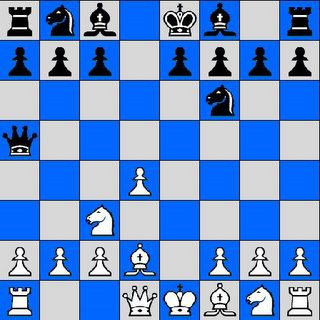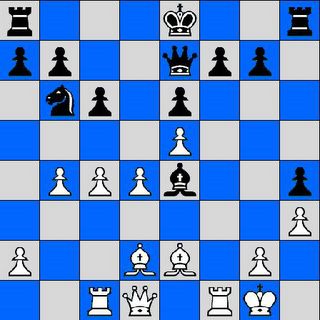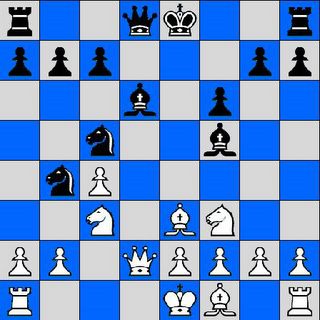Reflecting on a drama
This weekend I played a 6 round Swiss tournament OTB G/120
I first wanted to describe the results for you in the Sanskrta language, but when I looked for "skewering attack" and "prophylaxis" in Sir Monier Monier Williams great dictionary I decided to be honest with you and write it in English. Besides, there's always the risk that maybe Satish can translate Sanskrta back into English or he knows someone who can.
1,5 points out of 6.
Well, first there is the initial shame of course. Especially for you Knights. And my chessfriends who pester me for sitting at the lowest board, far below Margriet.
Second comes disappointment. I work on my tactics for about 6 months in a row and then this.
Shouldn't I buy a dartboard?
Then comes curiousity. What happened?
Then I feel lucky that before the next ratinglist is published we play in 2 tourneys (18 games Swiss G/180) in the last half of july so if I can understand what happened and adapt my trainingplan for the next two months maybe things can turn right.
What happened?
The first 2 games I was really out of luck.
In the first game I had outplayed my opponent totally.
I had 20 minutes for the final blow.
My opponent made a ridiculous attempt and threatened mate in one. I just had to make a defensive move and then press him off the board.
I thought for two minutes and made another move. I was forgotten that he threatened mate in one. . .
The second game I was busy to deliver mate. I needed only 2 more moves to mate. And 5 more seconds. . .
If these points should be mine, then I would operate according to my rating.
The third game was a regular loss, the fourth a regular draw and the fifth an oversight after a bad played opening. The sixth was a crushing win, a rooksacrifice from the textbooks and mate in 11. Here happened truly what my training is all about.
So only in one case my tactical training paid off. What went wrong in the other games?
I had a lot of timetrouble in my games.
What patterns do I miss in my brainlobes that make me so slow?
Because I train a lot of tactics, it can't be tactical patterns that I miss.
My mate in 11 proved that there is nothing wrong with my tactical skills at the moment (well, he could have played a little better but would die on great material deficit otherwise).
Lazy thinking lead me to the conclusion that if it are no tactical patterns I am lacking, it must be positional patterns.
So I downloaded a demo of Strategy 2.0 from Convekta and tried some problems.
Though this is extremely useful, I am convinced that another sort of problems causes me trouble behind the board.
Today I had taken a day off and decided to analyse my games to get more insight in the troubles.
I will show you a few critical positions.

Diagram 1.
I have white, black to play.
My last move was Bd2. I totally missed blacks next move: Qb6, with a double attack on d4 and b2. Well, because playing the bisshop back to c1 looks ugly I decided to make a gambit of it with Nf3.
But why do I miss a move like Qb6?
Tactical combinations are most about attacking two targets at the same time. A fork, a pin, a skewer etc. all have two targets. The attack can find place thru one piece (fork) or two pieces (discovered attack). The targets can be separated (fork) or in line (skewer, pin).
A target can be an un(der)protected piece, a piece of high value, an invasion field, a mate field/line/rank etc.
For defensive purpose you can make a move that protects two targets (=your own pieces)
Or your move can serve both an attack and a defense.
Beside this, you have all the preparational moves, to put your targets and attacking piec(es) in place.
That I missed such a simple double attack, did me question if my argument to not do the microdrills maybe was reprehensible arrogance.

Diagram 2.
I have white, white to move.
What I realized during analysis was that I have a lot of targets here to defend.
b4, c4, d4, and the invasion field g5.
During the game I didn't realized that and played Bh5.
Maybe a prophylactic move as a3 is better in place here.
What I am sure about is that it is a good idea to keep always an eye on your vulnerable targets.

Diagram 3.
I have black. White to move.
My last move was Bf5 to prefent white from castling queenside (=mate in two)
I totally missed Nd4. Attacking f5 and protecting c2.
So I asked my self if microdrills in the form of knightforks could have prevented me here?
Or is there a gap between Microdrills and Tactical problemsolving that has to be bridged?
For example by Extended Microdrills which are about knightforks in crowded places?

Diagram 4.
I have white, black to move.
My last move was e5.
e5 is not bad, but I didn't realize at that moment that I opened a diagonal for blacks bishop and that d5 becomes available for the black knight.
That's a problem that I often have, doing a (most pawn-)move that leave diagonals and fields behind. What kind of exercises could be of help here? What extended Chess Vision is necessary?

Diagram 5.
I have white, white to move.
I did Bd4 here.
Attacking the defender of the rook.
I had looked at Qf4+ and c5 for black and had prepared Qc4 as an answer.
But I hadn't looked further, to Nd7, after which white looses a piece.
What happened here was that in order to avoid timetrouble, I cut in calculating too deep.
So one solution caused another problem. I'm not sure why the alarmbell didn't ring here.
Conclusion.
If I look to all the examples above, I have to say that the things I miss are simple in general.
This means that the solution probably is simple too.
So the next two months I will do microdrills, of course with Fussy Lizzards excellent Chess Vision Trainer
And I will experiment with Extended Microdrills.
Besides the result I had a great tournament with exciting games.
Overall I feel optimistic that I can make another step now to tackle this important problem.
I'll keep you informed. . .
Update.
A warm welcome to RomaLvrn, a new but already graduated Knight and dubbed Pomaranch Knight.
I first wanted to describe the results for you in the Sanskrta language, but when I looked for "skewering attack" and "prophylaxis" in Sir Monier Monier Williams great dictionary I decided to be honest with you and write it in English. Besides, there's always the risk that maybe Satish can translate Sanskrta back into English or he knows someone who can.
1,5 points out of 6.
Well, first there is the initial shame of course. Especially for you Knights. And my chessfriends who pester me for sitting at the lowest board, far below Margriet.
Second comes disappointment. I work on my tactics for about 6 months in a row and then this.
Shouldn't I buy a dartboard?
Then comes curiousity. What happened?
Then I feel lucky that before the next ratinglist is published we play in 2 tourneys (18 games Swiss G/180) in the last half of july so if I can understand what happened and adapt my trainingplan for the next two months maybe things can turn right.
What happened?
The first 2 games I was really out of luck.
In the first game I had outplayed my opponent totally.
I had 20 minutes for the final blow.
My opponent made a ridiculous attempt and threatened mate in one. I just had to make a defensive move and then press him off the board.
I thought for two minutes and made another move. I was forgotten that he threatened mate in one. . .
The second game I was busy to deliver mate. I needed only 2 more moves to mate. And 5 more seconds. . .
If these points should be mine, then I would operate according to my rating.
The third game was a regular loss, the fourth a regular draw and the fifth an oversight after a bad played opening. The sixth was a crushing win, a rooksacrifice from the textbooks and mate in 11. Here happened truly what my training is all about.
So only in one case my tactical training paid off. What went wrong in the other games?
I had a lot of timetrouble in my games.
What patterns do I miss in my brainlobes that make me so slow?
Because I train a lot of tactics, it can't be tactical patterns that I miss.
My mate in 11 proved that there is nothing wrong with my tactical skills at the moment (well, he could have played a little better but would die on great material deficit otherwise).
Lazy thinking lead me to the conclusion that if it are no tactical patterns I am lacking, it must be positional patterns.
So I downloaded a demo of Strategy 2.0 from Convekta and tried some problems.
Though this is extremely useful, I am convinced that another sort of problems causes me trouble behind the board.
Today I had taken a day off and decided to analyse my games to get more insight in the troubles.
I will show you a few critical positions.

Diagram 1.
I have white, black to play.
My last move was Bd2. I totally missed blacks next move: Qb6, with a double attack on d4 and b2. Well, because playing the bisshop back to c1 looks ugly I decided to make a gambit of it with Nf3.
But why do I miss a move like Qb6?
Tactical combinations are most about attacking two targets at the same time. A fork, a pin, a skewer etc. all have two targets. The attack can find place thru one piece (fork) or two pieces (discovered attack). The targets can be separated (fork) or in line (skewer, pin).
A target can be an un(der)protected piece, a piece of high value, an invasion field, a mate field/line/rank etc.
For defensive purpose you can make a move that protects two targets (=your own pieces)
Or your move can serve both an attack and a defense.
Beside this, you have all the preparational moves, to put your targets and attacking piec(es) in place.
That I missed such a simple double attack, did me question if my argument to not do the microdrills maybe was reprehensible arrogance.

Diagram 2.
I have white, white to move.
What I realized during analysis was that I have a lot of targets here to defend.
b4, c4, d4, and the invasion field g5.
During the game I didn't realized that and played Bh5.
Maybe a prophylactic move as a3 is better in place here.
What I am sure about is that it is a good idea to keep always an eye on your vulnerable targets.

Diagram 3.
I have black. White to move.
My last move was Bf5 to prefent white from castling queenside (=mate in two)
I totally missed Nd4. Attacking f5 and protecting c2.
So I asked my self if microdrills in the form of knightforks could have prevented me here?
Or is there a gap between Microdrills and Tactical problemsolving that has to be bridged?
For example by Extended Microdrills which are about knightforks in crowded places?

Diagram 4.
I have white, black to move.
My last move was e5.
e5 is not bad, but I didn't realize at that moment that I opened a diagonal for blacks bishop and that d5 becomes available for the black knight.
That's a problem that I often have, doing a (most pawn-)move that leave diagonals and fields behind. What kind of exercises could be of help here? What extended Chess Vision is necessary?

Diagram 5.
I have white, white to move.
I did Bd4 here.
Attacking the defender of the rook.
I had looked at Qf4+ and c5 for black and had prepared Qc4 as an answer.
But I hadn't looked further, to Nd7, after which white looses a piece.
What happened here was that in order to avoid timetrouble, I cut in calculating too deep.
So one solution caused another problem. I'm not sure why the alarmbell didn't ring here.
Conclusion.
If I look to all the examples above, I have to say that the things I miss are simple in general.
This means that the solution probably is simple too.
So the next two months I will do microdrills, of course with Fussy Lizzards excellent Chess Vision Trainer
And I will experiment with Extended Microdrills.
Besides the result I had a great tournament with exciting games.
Overall I feel optimistic that I can make another step now to tackle this important problem.
I'll keep you informed. . .
Update.
A warm welcome to RomaLvrn, a new but already graduated Knight and dubbed Pomaranch Knight.
Don't worry, things will get better. I know this feeling very well. Had done a lot of training and then lost in a row against low-rated opponents! I am a bit sceptical about microdrills, especially on an empty board I find them quite useless because this does not pay off with a crowded board. I think your problem might be prophylaxis, time management and too much focus on your own versus opponent plans. My own plan after circles are finished will be more work on my list of positional patterns and trying to identify them by playing master games.
ReplyDeleteI know the feeling well. Did I not finish 1/5 in my last tournament? Avoiding one-move garbages is also an on-going problem for me. Hope you do better next time
ReplyDeleteTempo, re: Diagram 1
ReplyDeleteI think you shouldn't worry about Qxb2?? After Qb6, simply play Nf3. Then, his black can get into all sorts of trouble after Qxb2?? Nb5! Threatening Nxc7+ winning a rook as well as Bc3 winning the queen.
CD, you are right ofcourse. The position doesn't trouble me.
ReplyDeleteWhat does is the fact that I didn't see it coming at all. I'm often vulnarable the first six moves or so due to lack of focus. It was only a coincidence that the trouble wasn't real.
Sometimes, I don't see everything in the opening, too. However, it is difficult to really blunder in the opening. Often there are resources in the position such that if you play active opening moves that help you get your pieces out, you shouldn't worry if you opp stops to take a pawn (especially if he is moving a piece more than once to do so). Then you can get a development advantage over him. In such instances, I may make a move that may lose the pawn, but I then take extra time to uncover the resources in the position knowing that I have been good to Caissa and Caissa will be good to me!
ReplyDeleteThere are many opening traps, CD. And yes, gambits are never blunders, only more or less sound.
ReplyDeleteTempo, this link might help organize the post mortems.
ReplyDelete